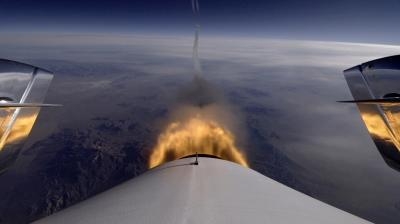Chief Pilot Proves Space Systems
Virgin Galactic successfully completed the third rocket-powered supersonic flight of its passenger carrying reusable space vehicle, SpaceShipTwo (SS2) Friday. In command on the flight deck of SS2 for the first time under rocket power was Virgin Galactic’s Chief Pilot Dave Mackay. Mackay, along with Scaled Composites’ (Scaled) Test Pilot Mark Stucky, tested the spaceship’s Reaction Control System (RCS) and the newly installed thermal protection coating on the vehicle’s tail booms. All of the test objectives were successfully completed.

Today’s flight departed Mojave Air and Space Port at 0722 PST with the first stage consisting of the WhiteKnightTwo (WK2) carrier aircraft lifting SS2 to an altitude around 46,000 ft. At the controls of WK2 were Virgin Galactic Pilot Mike Masucci and Scaled Test Pilot Mike Alsbury. On release, SS2’s rocket motor was ignited, powering the spaceship to a planned altitude of 71,000 ft. – SS2’s highest altitude to date – and at a maximum speed of Mach 1.4. SS2’s unique feather re-entry system was also tested during today’s flight.
Two important SS2 systems, the RCS and thermal protection coating, were tested during today’s flight in preparation for upcoming full space flights. The spaceship’s RCS will allow its pilots to maneuver the vehicle in space, permitting an optimal viewing experience for those on board and aiding the positioning process for spacecraft re-entry. The new reflective protection coating on SS2’s inner tail boom surfaces is being evaluated to help maintain vehicle skin temperatures while the rocket motor is firing.
SS2’s propulsion system has been developed by Sierra Nevada Corp and is the world’s largest operational hybrid rocket motor. Although today’s flight saw it burn for a planned 20 seconds, the system has been successfully tested in ground firings to demonstrate performance characteristics and burn time sufficient to take the spaceship and its private astronauts to space.
Commenting on the successful test flight, Sir Richard Branson said: “I couldn’t be happier to start the New Year with all the pieces visibly in place for the start of full space flights. 2014 will be the year when we will finally put our beautiful spaceship in her natural environment of space. Today, we had our own Chief Pilot flying another flawless supersonic flight and proving the various systems required to take us safely to space, as well as providing the very best experience while we’re up there.”

This flight was the third opportunity to see a supersonic, rocket-powered test of the Virgin Galactic system after dozens of successful subsonic test flights. “Today’s flight was another resounding success,” said Virgin Galactic CEO George Whitesides. “We focused on gathering more transonic and supersonic data, and our chief pilot, Dave, handled the vehicle beautifully. With each flight test, we are progressively closer to our target of starting commercial service in 2014.”
For Mackay, the flight was a “dream come true.”
“I have watched SS2 evolve over the years into an incredible vehicle that is going to open up space to more people than ever before,” he said. “To be behind the controls and fly it as the rocket ignited is something I will never forget. She flew brilliantly. All the tests went really well and generated vital data that will be used to further fine-tune our operations.”
 ANN's Daily Aero-Term (04.26.24): DETRESFA (Distress Phrase)
ANN's Daily Aero-Term (04.26.24): DETRESFA (Distress Phrase) ANN's Daily Aero-Linx (04.26.24)
ANN's Daily Aero-Linx (04.26.24) Airborne 04.22.24: Rotor X Worsens, Airport Fees 4 FNB?, USMC Drone Pilot
Airborne 04.22.24: Rotor X Worsens, Airport Fees 4 FNB?, USMC Drone Pilot Airborne 04.24.24: INTEGRAL E, Elixir USA, M700 RVSM
Airborne 04.24.24: INTEGRAL E, Elixir USA, M700 RVSM Airborne-NextGen 04.23.24: UAVOS UVH 170, magni650 Engine, World eVTOL Directory
Airborne-NextGen 04.23.24: UAVOS UVH 170, magni650 Engine, World eVTOL Directory




